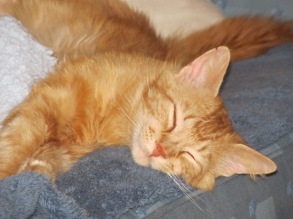I spent a wonderful afternoon at the zoo on Monday with my best friend. The weather was practically perfect, and many of the animals and birds were quite active; the cats, however, seemed one and all to be enjoying the mid-day sun with an extended snooze fest! Happily, we were there in time to see the Big Cat training demonstration, a daily feature at the zoo during the summer season. This turned out to be one of the highlights of our day!
The demonstration featured Malcolm: a very handsome male Jaguar, about 13 years old, with a massive head for his size, a gorgeous coat of rosettes, and grey eyes that held you captive in their unblinking gaze. This was an impressive cat, and he definitely knew that the gathering of humans at his enclosure meant that it was training and reward time.
The purpose of the zoo’s animal training is not to teach the cats “tricks” to show off for visitors, but rather to develop natural behaviors in order to have the animals do them as needed for physical exams and medical treatments. This results in a much less stressful and fearful experience for the cat (and the handlers too, I expect!) and for some procedures even allows the animals to avoid sedation. The animal’s participation in the training and procedures is voluntary and is always reinforced with a reward, such as a yummy piece of raw meat! Animals who choose not to participate are never punished, they just lose out on a snack.
We watched in awe as Malcolm showed off his skills: holding up his paw, lying down next to the enclosure’s fence and allowing his tail to slip through so the keeper could hold it, allowing a poke in his flank from a blunted syringe, and standing up on his back legs and stretching out full length to show his chest and belly (wow!) These behaviors will permit the keepers or veterinarians to trim or file claws, visually assess wounds or lumps, apply topical medications or ointments, take blood, give injections, and even take the cat’s blood pressure, all without entering the animal’s enclosure. All with the animal’s permission!!
Of course, it takes time, patience, and commitment to train a wild animal to learn to perform these behaviors “on command,” but it certainly seems to be well worth it for everyone involved. I really need to work on training my two “wild” cats at home to submit graciously to nail trims and coat brushing: life would be easier for all of us!!

